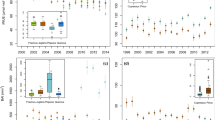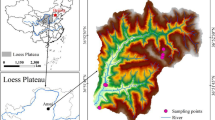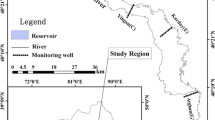Abstract
Key message
Water productivity of 3-year-old Paulownia tomentosa x fortunei (Shan Tong) trees in a plantation at Lake Issyk-Kul (Kyrgyzstan) ranged between 4.3 and 8.0 g l−1 over the vegetation period 2019.
Abstract
Central Asia is a region where forests are naturally scarce and additionally are under high anthropogenic pressure due to an unmet demand for timber and fuelwood. Cultivation of fast-growing trees as a means to satisfy this need may, therefore, be instrumental to forest conservation and/or restoration efforts. In recent years, there has been a growing interest in Paulownia spp. as agroforestry or plantation tree. Paulownia is a deciduous tree genus of Chinese origin that is valued for its fast growth and light, yet sturdy wood, among other characteristics. This study investigated the water consumption, biomass production, and water productivity of Paulownia tomentosa x fortunei (trade name: Shan Tong) in a plantation setting on the northern shore of Lake Issyk-Kul (Kyrgyzstan) over the course of the vegetation period 2019. The method employed was Granier’s thermal dissipation probe for measuring sap flow in trees. Estimated trunk biomass production per tree and season ranged from 1.52 to 3.41 kg, and the trees were found to consume between 433 and 613 l of water in total over the growing season. Water productivity, the amount of exploitable stem biomass produced per litre of water input, consequently ranged between 4.3 and 8.0 g l−1. As numerous studies suggest that the thermal dissipation method underestimates tree water consumption to varying degrees, these values likely represent the upper range of the species’ water productivity. A literature review shows its water productivity to be higher than that of regionally employed tree species such as Populus euphratica or Elaeagnus angustifolia.





Similar content being viewed by others
References
Akyildiz MH, Hamiyet SK (2010) Some technical properties and uses of paulownia (Paulownia tomentosa Steud.) wood. J Environ Biol 31:351–355 (PMID: 21047010)
Allen RG, Pereira LS, Raes D, Smith M (1998) Crop Evapotranspiration—Guidelines for Computing Crop Water Requirements; FAO Irrigation and Drainage Paper 56; FAO: Rome, Italy.
Andivia E, Fernández M, Alaejos J, Tapias R (2013) Consumo de agua de distintas especies leñosas utilizables como cultivos energéticos. 6º Congreso Forestal Español. https://www.congresoforestal.es/actas/doc/6CFE/6CFE01-122.pdf. Accessed 21 June 2020
Basu C, Joshee N, Gezalian T, Vaidya BN, Satidkit A, Hemmati H, Perry ZD (2015) Cross-species PCR and field studies on Paulownia elongata: a potential bioenergy crop. Bioethanol 2. https://doi.org/https://doi.org/10.1515/bioeth-2015-0002
Bernauer T, Siegfried T (2012) Climate change and international water conflict in Central Asia. J Peace Res 49:227–239. https://doi.org/10.1177/0022343311425843
Bobojonov I, Aw-Hassan A (2014) Impacts of climate change on farm income security in Central Asia: an integrated modeling approach. Agr Ecosyst Environ 188:245–255. https://doi.org/10.1016/j.agee.2014.02.033
Bork J, Walter E, Mosandl R, Stimm B (2015) Paulownia—vorläufige Ergebnisse zu Möglichkeiten und Grenzen des Anbaus im Wald. Forstarchiv 86:102–106. https://doi.org/10.4432/0300-4112-86-102
Bush SE, Hultine KR, Sperry JS, Ehleringer JR (2010) Calibration of thermal dissipation sap flow probes for ring- and diffuse-porous trees. Tree Physiol 30:1545–1554. https://doi.org/10.1093/treephys/tpq096
Chaires M, Gupta D, Joshee N, Cooper KK, Basu C (2017) RNA-seq analysis of the salt stress-induced transcripts in fast-growing bioenergy tree, Paulownia elongata. J Plant Interactions 12(1):128–136. https://doi.org/10.1080/17429145.2017.1298851
Chinese Academy of Forestry (1986) Paulownia in China: Cultivation and Utilization. Asian Network for Biological Sciences and International Development Research Centre, Beijing
Clearwater MJ, Meinzer FC, Andrade JL, Goldstein G, Holbrook NM (1999) Potential errors in measurement of nonuniform sap flow using heat dissipation probes. Tree Physiol 19:681–687. https://doi.org/10.1093/treephys/19.10.681
Dörrie HL (2018) Sap flow measurements of Paulownia to assess their water use with regard to shelterbelts in Kyrgyzstan. Bachelor Thesis, Rhine-Waal University of Applied Sciences
Eastwood A, Lazkov G, Newton A (2009) The Red List of Trees in Central Asia. https://portals.iucn.org/library/sites/library/files/documents/RL-2009-006.pdf. Accessed 31 Oct 2019
FAO (2020) Global Forest Resources Assessment. Country Reports 2020. http://www.fao.org/forest-resources-assessment/fra-2020/country-reports/en/. Accessed 2 Aug 2020
Flo V, Martinez-Vilalta J, Steppe K, Schuldt B, Poyatos R (2019) A synthesis of bias and uncertainty in sap flow methods. Agric for Meteorol 271:362–374. https://doi.org/10.1016/j.agrformet.2019.03.012
Fuchs S, Leuschner C, Link R, Coners H, Schuldt B (2017) Calibration and comparison of thermal dissipation, heat ratio and heat field deformation sap flow probes for diffuse-porous trees. Agric for Meteorol 244–245:151–161. https://doi.org/10.1016/j.agrformet.2017.04.003
Gottschling H (2006) Die Naturräume des Biosphärenreservates Issyk-Kul in Kirgisistan. Eine landschaftsökologische Studie an Transekten. Dissertation, University of Greifswald
Granier A (1985) A new method of sap flow measurement in tree stems. Ann Sci for 42:193–200
Hecker U, Weisgerber H (2003) Paulownia tomentosa (THUNB. ex MURRAY) STEUD., 1841. In: Enzyklopädie der Holzgewächse. Handbuch und Atlas der Dendrologie, Roloff A, Weisgerber H, Lang UM, Stimm B (eds), Wiley-VCH. https://doi.org/https://doi.org/10.1002/9783527678518.ehg2003018
Icka P, Damo R, Icka E (2016) Paulownia Tomentosa, a Fast Growing Timber. Annals ”Valahia” University of Targoviste - Agriculture 10:14–19. https://doi.org/https://doi.org/10.1515/agr-2016-0003
Joshee N (2012) Paulownia: A Multipurpose Tree for Rapid Lignocellulosic Biomass Production. In: Kole C, Joshi CP, Shonnard D (eds) Handbook of Bioenergy Crop Plants. CRC Press. ISBN 9780367381592
Kassam AH, Molden D, Fereres E, Doorenbos J (2007) Water productivity: science and practice—introduction. Irrig Sci 25:185–188. https://doi.org/10.1007/s00271-007-0068-x
Khamzina A, Lamers JPA, Worbes M, Botman E, Vlek PLG (2006) Assessing the potential of trees for afforestation of degraded landscapes in the Aral Sea Basin of Uzbekistan. Agrofor Syst 66:129–141. https://doi.org/10.1007/s10457-005-4677-1
Khamzina A, Sommer R, Lamers JPA, Vlek PLG (2009) Transpiration and early growth of tree plantations established on degraded cropland over shallow saline groundwater table in northwest Uzbekistan. Agric for Meteorol 149:1865–1874. https://doi.org/10.1016/j.agrformet.2009.06.015
Li P, Oda J (2007) Flame retardancy of paulownia wood and its mechanism. J Mater Sci 42:8544–8550. https://doi.org/10.1007/s10853-007-1781-9
Nelis PA, Mai C (2019) Improved strength properties of three-layered particleboards with different core and surface layers based on Kiri wood (Paulownia spp.). Euro J Wood Wood Products 77:761–769. https://doi.org/10.1007/s00107-019-01442-7
Oishi AC, Hawthorne DA, Oren R (2016) Baseliner: an open-source, interactive tool for processing sap flux data from thermal dissipation probes. SoftwareX 5:139–143. https://doi.org/10.1016/j.softx.2016.07.003
Qi Y, Yang C, Hidayat W, Jang J-H, Kim N-H (2016) Solid bioenergy properties of paulownia tomentosa grown in Korea. J Korean Wood Sci Technol 44(6):890–896. https://doi.org/10.5658/WOOD.2016.44.6.890
Reyer CPO, Otto IM, Adams S, Albrecht T, Baarsch F, Cartsburg M, Coumou D, Eden A, Ludi E, Marcus R, Mengel M, Mosello B, Robinson A, Schleussner C-F, Serdeczny O, Stagl J (2015) Climate change impacts in Central Asia and their implications for development. Reg Environ Change 17:1639–1650. https://doi.org/10.1007/s10113-015-0893-z
Reyer CPO, Rigaud KK, Fernandes E, Hare W, Serdeczny O, Schellnhuber HJ (2017) Turn down the heat: regional climate change impacts on development. Reg Environ Change 17:1563–1568. https://doi.org/10.1007/s10113-017-1187-4
Smith DM, Allen SJ (1996) Measurement of sap flow in plant stems. J Exp Bot 47:1833–1844. https://doi.org/10.1093/jxb/47.12.1833
Steppe K, De Pauw DJW, Doody TM, Teskey RO (2010) A comparison of sap flux density using thermal dissipation, heat pulse velocity and heat field deformation methods. Agric for Meteorol 150:1046–1056. https://doi.org/10.1016/j.agrformet.2010.04.004
Stimm B, Stiegler J, Genser C, Wittkopf S, Mosandl R (2013) Paulownia—Hoffnungsträger aus Fernost? Eine schnellwachsende Baumart aus China in Bayern auf dem Prüfstand. LWF Aktuell 96:18–21
Sutton WR, Srivastava JP, Neumann JE (2013) Looking Beyond the Horizon. https://documents.worldbank.org/en/publication/documents-reports/documentdetail/676601468249642651/looking-beyond-the-horizon-how-climate-change-impacts-and-adaptation-responses-will-reshape-agriculture-in-eastern-europe-and-central-asia. Accessed 12 Jan 2020
Thomas FM, Foetzki A, Arndt SK, Bruelheide H, Gries D, Li X, Zeng F, Zhang X, Runge M (2006) Water use by perennial plants in the transition zone between river oasis and desert in NW China. Basic Appl Ecol 7:253–267. https://doi.org/10.1016/j.baae.2005.07.008
Undeland A, Mitchell AM (2015) Kyrgyz Republic—Communities, Forests, and Pastures. https://documents.worldbank.org/en/publication/documents-reports/documentdetail/550371468263989781/kyrgyz-republic-communities-forests-and-pastures. Accessed 15 June 2019
UNECE (2019) Forest Landscape Restoration in the Caucasus and Central Asia - Challenges and Opportunities. Background study for the Ministerial Roundtable on Forest Landscape Restoration in the Caucasus and Central Asia (21–22 June 2018, Astana, Kazakhstan). http://www.unece.org/fileadmin/DAM/timber/Forest_Policy/Capacity_building/FLR_CCA_challenges___opportunities_081018-ENG-edited.pdf. Accessed 11 July 2020
United Nations (2019) World Population Prospects 2019: Ten Key Findings. https://population.un.org/wpp/Publications/Files/WPP2019_10KeyFindings.pdf. Accessed 14 December 2019
Villwock D (2019) Water productivity of Poplar and Paulownia as fast-growing trees in Central Asia. Master Thesis, University of Hohenheim
Yadav NK, Vaidya BN, Henderson K, Lee JF, Stewart WM, Dhekney SA, Joshee N (2013) A review of paulownia biotechnology: a short rotation, fast growing multipurpose bioenergy tree. Am J Plant Sci 4:2070–2082. https://doi.org/10.4236/ajps.2013.411259
Yin H, Khamzina A, Pflugmacher D, Martius C (2017) Forest cover mapping in post-Soviet Central Asia using multi-resolution remote sensing imagery. Sci Rep 7:1375. https://doi.org/10.1038/s41598-017-01582-x
Zotarelli L, Dukes MD, Romero CC, Migliaccio KW, Morgan KT (2010) Step by Step Calculation of the Penman-Monteith Evapotranspiration (FAO-56 Method). https://edis.ifas.ufl.edu/pdffiles/ae/ae45900.pdf. Accessed 04 July 2019
Acknowledgements
We thank the German Academic Exchange Service (DAAD), specifically the programme RISE Worldwide, for issuing a scholarship that enabled Clara Baier to carry out research in Kyrgyzstan. Niels Thevs’ position as an integrated expert at the World Agroforestry Center as well as the sap flow equipment and climate station were co-funded by the German Federal Ministry of Economic Cooperation and Development (BMZ) as part of the Center for International Migration and Development (CIM) programme. We furthermore express our gratitude to the land owner of the Paulownia plantation for his support with this study.
Funding
Funding was provided by the German Academic Exchange Service (DAAD) to Clara Baier (in form of a RISE Worldwide Scholarship) and to Daniel Villwock (PROMOS Programme) for their respective field research in Kyrgyzstan. Niels Thevs’ position as an integrated expert at World Agroforestry as well as the sap flow equipment and the climate stations were co-funded by BMZ as part of the Centre for International Migration and Development (CIM) programme.
Author information
Authors and Affiliations
Corresponding author
Ethics declarations
Conflicts of interest
None.
Additional information
Communicated by R. Guy.
Publisher's Note
Springer Nature remains neutral with regard to jurisdictional claims in published maps and institutional affiliations.
Rights and permissions
About this article
Cite this article
Baier, C., Thevs, N., Villwock, D. et al. Water productivity of Paulownia tomentosa x fortunei (Shan Tong) in a plantation at Lake Issyk-Kul, Kyrgyzstan, Central Asia. Trees 35, 1627–1637 (2021). https://doi.org/10.1007/s00468-021-02141-8
Received:
Accepted:
Published:
Issue Date:
DOI: https://doi.org/10.1007/s00468-021-02141-8




